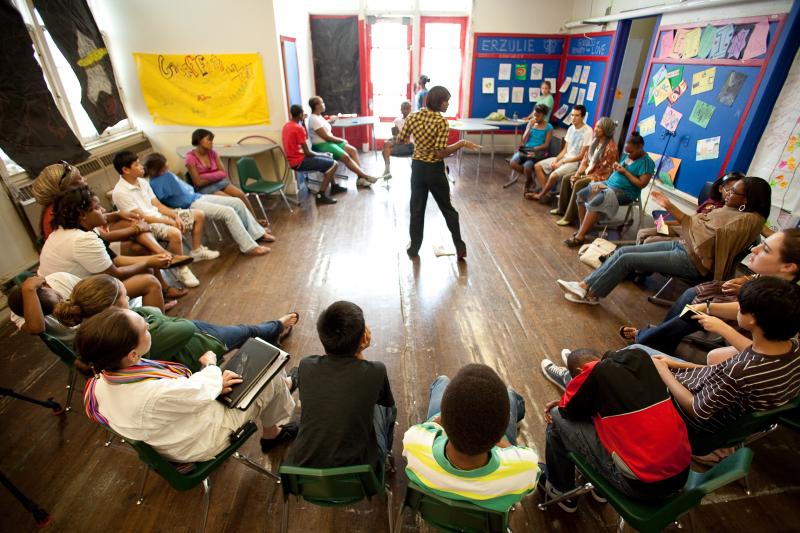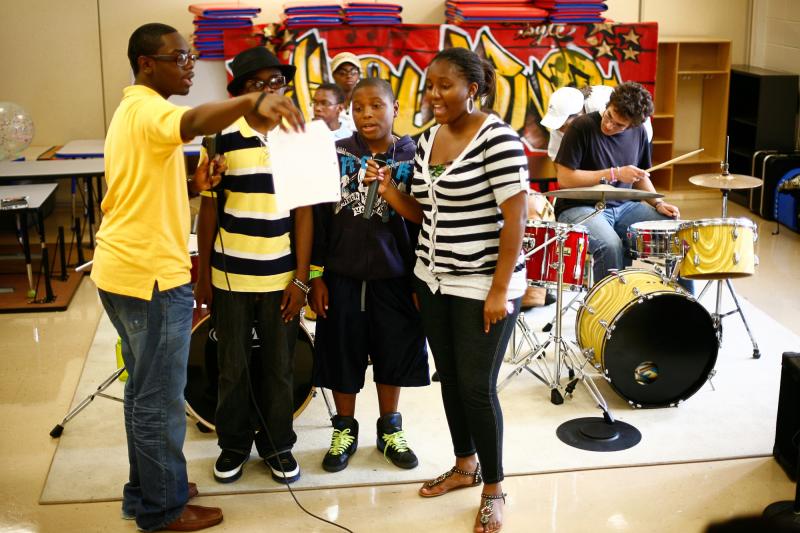Photos by Colin M. Lenton
Singing during a different era, Gil Scott-Heron claimed that “the revolution will not be televised,” but in the case of Kids Rethink New Orleans Schools, or the Rethinkers, the revolution is being televised. The Rethinkers, a group of motivated middle-school students from New Orleans, are creating their own revolution within the resurgent New Orleans schools and are attracting broad press attention as they do so, including recent coverage by ABC-TV News and the Huffington Post. Credible stakeholders in the future of their schools, the Rethinkers delivered their recommendations and visions for New Orleans’ schools at their press conference via the empowering vehicles of song, percussion, and spoken word.

The library-turned-conference-room at the newly rebuilt Langston Hughes Academy fell silent as Rethinkers Earl Poole Jr. and Terriana Julien began their performance. Drummer Tori Washington created a meditative texture with crescendoing cymbal rolls as Poole and Julien began to sing “Reee…storative Juuuu…stice.” As the jam-packed audience of media, education activists, school administrators, principals, and proud parents clapped, Lucy Tucker, Renee Smith, and Kamau Johnson took the stage. Addressing a rapt audience, they discussed the culture of violence and discipline in their schools and stated they wanted an alternative to suspension and expulsion—practices, they said, that add to school dropout rates and the “school-to-prison pipeline.” Their alternative: something called restorative justice.
After months of forced relocation following Hurricane Katrina, families began to return to New Orleans to a shrunken school district in turmoil and contention over competing visions for schools. The public schools, among the poorest in the country before the storm, were largely taken over by the state of Louisiana in the newly created Recovery School District (RSD). The RSD operated most of the schools at first, but a charter school movement quickly grew. Today New Orleans has more charter schools than any other city in the United States.
After Katrina, grassroots media consultant Jane Wholey and a group of community organizers began advocating a radically simple idea: Give students a role in rethinking and rebuilding the post-Katrina schools. Together, they decided to form Rethink, with Wholey at the helm. They believed that an organization of student education reformers could gain credibility because, as Wholey stated, “No one in the world can claim that students are not experts on their own schools.”
Realizing and leveraging their own expertise for years now, the Rethinkers have identified fundamental areas for reform. During the early years, they addressed “bathroom reform,” successfully convincing RSD Superintendent Paul Vallas to renovate 250 bathrooms. He also added their design for a “21st Century Green Bathroom” to the Public School Facilities Plan for the City of New Orleans. After bathrooms, the Rethinkers tackled school lunches, exploring ways that school lunch programs could provide local, fresh, and enjoyable foods. Then in 2009, they set out to address “dignity in schools” and humane security measures that keep children really safe—not the metal detectors that greet many elementary school children at New Orleans schools.
Healing Schools Through Restorative Justice
This past summer, the Rethinkers identified the punitive practices of suspension and expulsion in their schools as a barrier to healthy, truly safe school environments. The Rethinkers understand firsthand the culture of violence and distrust that marks many of their schools. As Rethinker Lucy Tucker explains, schools treat offenses in a very simple way, through suspensions and expulsions, leading to a culture of distrust between students, teachers, and administrators.
The Rethinkers realized that restorative justice could be an alternative to this vicious cycle, a whole new way of dealing with offenses, focusing on repairing the harm that has been done between members of a school community. In restorative justice programs, students talk out their problems in a safe space, examine the harm done, and come to an agreement about how the harm can be repaired and the relationships mended. The agreement is monitored by an adult.
Restorative justice programs have had impressive success in other parts of the country. Press conference guest speaker Dr. Beverly Title reviewed the success of restorative justice in Colorado and relayed how state law in Colorado now mandates restorative justice practices prior to formal discipline, further underscoring the appropriateness and timeliness of Rethink’s advocacy for the expansion of restorative justice programs throughout the RSD and charter schools. Their vision is that by the 10-year anniversary of Katrina in 2015, all New Orleans schools will have restorative justice programs.

Rethinking Music Education
Following on this theme, the students wrote and performed songs that added lasting weight and meaning to their ideas. The Rethink summer program partnered with the Jazz Hip-Hop Orchestra (JHO), led by Director Angelamia Bachemin and Vocal Director M. Gingerbread Tanner. Bachemin established JHO during her years as a professor at Berklee School of Music in Boston. JHO became one of the most popular ensembles at Berklee, touring across the country and recording.
Upon returning to her birth home of New Orleans in 2003, Bachemin expanded the mission and reach of JHO as an educational and community-building ensemble. Partnering with Tanner, Bachemin has turned JHO into a vital umbrella for youth music education projects throughout New Orleans. The two women began working with Rethink in the “Rethink Clubs,” teaching percussion at various public schools during the past academic year.
Building on the musical skills learned during the school year, the Rethink summer program enabled students to merge music with their visions for better schools. Sitting in a circle in the mornings, Rethinkers identified specific problems in their schools, envisioned solutions, and developed recommendations for change. By the afternoons, the Rethinkers were ready for music and movement, reflecting on the work of the mornings, while exploring their artistic selves and creating music that could strengthen the power of their recommendations at the fast-approaching press conference.
As the Rethinkers realized a vision for restorative justice programs in their schools, they partnered with a local landscape architect to design an outdoor restorative justice circle—a place where reconciliation work can take place at a school. The Rethinkers’ circle may well be the first outdoor design for a school in the United States and is certainly the first to be designed by the students themselves.
George Carter explained at the press conference, pointing to a rendering of the circle design, “Having a beautiful space outdoors in Mother Nature can get kids in the mood to solve their problems.” George’s older brother Vernard, a junior, went on to explain the Rethink design: “We drew one path in and a different one out. That symbolizes coming in one way and leaving out on a different path.”
Redefining Possibilities, Ensuring Outcomes
The Rethinkers have earned respect in the New Orleans educational community for not only protesting against the poor state of their schools but actively developing solutions and holding the powers-that-be accountable. Their recommendations have often been implemented, leading to tangible improvements in the quality of the education, the physical surroundings, and the community climate of New Orleans schools.
With one pilot restorative justice program already under way in a high school and a new pilot program beginning at an elementary school in September—the Langston Hughes Academy—the landscape for creating more restorative justice programs in New Orleans is promising. An organization called the Center for Restorative Approaches runs both of these programs. But in the case of the elementary school, the Rethinkers will take an active part in organizing and educating students.
The Rethink model has remained the same since 2006: empower young folks to think and act big and develop power among peers for change. Rethinkers have gone beyond protest for a long time now, and with the communicative power of music, their sense of personal empowerment is growing ever stronger. More people all over the country are listening to both their protests and their solutions.
This article first appeared in the October 11, 2010, San Francisco BayView.
Last December, the Rethinkers released their first book, the graphic novel Feet To the Fire: The Rethinkers’ Guide to Changing Your School. Purchase the book for $15.00 online at www.therethinkers.com.



